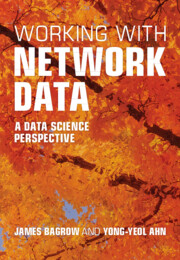Book contents
- Frontmatter
- Contents
- Preface
- Part I Background
- Part II Applications, tools, and tasks
- Interlude — Good practices for scientific computing
- Part III Fundamentals
- Chapter 21 Networks demand network thinking: the friendship paradox
- Chapter 22 Network models
- Chapter 23 Statistical models and inference
- Chapter 24 Uncertainty quantification and error analysis
- Chapter 25 Ghost in the matrix: spectral methods for networks
- Chapter 26 Embedding and machine learning
- Chapter 27 Big data and scalability
- Conclusion
- Bibliography
- Index
Chapter 24 - Uncertainty quantification and error analysis
from Part III - Fundamentals
Published online by Cambridge University Press: 06 June 2024
- Frontmatter
- Contents
- Preface
- Part I Background
- Part II Applications, tools, and tasks
- Interlude — Good practices for scientific computing
- Part III Fundamentals
- Chapter 21 Networks demand network thinking: the friendship paradox
- Chapter 22 Network models
- Chapter 23 Statistical models and inference
- Chapter 24 Uncertainty quantification and error analysis
- Chapter 25 Ghost in the matrix: spectral methods for networks
- Chapter 26 Embedding and machine learning
- Chapter 27 Big data and scalability
- Conclusion
- Bibliography
- Index
Summary
As we have seen, network data are necessarily imperfect. Missing and spurious nodes and edges can create uncertainty in what the observed data tell us about the original network. In this chapter, we dive deeper into tools that allow us to quantify such effects and probe more deeply into the nature of an unseen network from our observations. The fundamental challenge of measurement error in network data is capturing the error-producing mechanism accurately and then inferring the unseen network from the (imperfectly) observed data. Computational approaches can give us clues and insights, as can mathematical models. Mathematical models can also build up methods of statistical inference, whether in estimating parameters describing a model of the network or estimating the networks structure itself. But such methods quickly become intractable without taking on some possibly severe assumptions, such as edge independence. Yet, even without addressing the full problem of network inference, in this chapter, we show valuable ways to explore features of the unseen network, such as its size, using the available data.
Keywords
Information
- Type
- Chapter
- Information
- Working with Network DataA Data Science Perspective, pp. 377 - 396Publisher: Cambridge University PressPrint publication year: 2024
Accessibility standard: Unknown
Why this information is here
This section outlines the accessibility features of this content - including support for screen readers, full keyboard navigation and high-contrast display options. This may not be relevant for you.Accessibility Information
- 1
- Cited by
